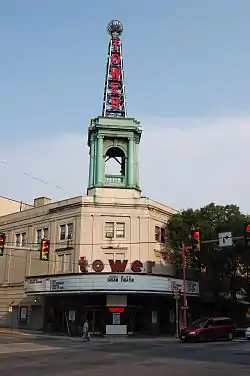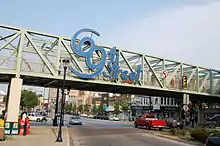Norristown High Speed Line
The Norristown High Speed Line (NHSL), the P&W, or Route 100,[4] is a 13.4-mile (21.6 km)[3] interurban light rapid transit line operated by SEPTA, running between the 69th Street Transportation Center in Upper Darby and the Norristown Transportation Center in Norristown, Pennsylvania. Originally the Philadelphia and Western Railroad line (which is why the line is referred to by locals as "the P&W"), the line runs entirely on its own right-of-way. By 2020, the Norristown High Speed Line had an average weekday ridership approaching 11,000 passengers.[5]
| Norristown High Speed Line | ||||||||||||||||||||||||||||||||||||||||||||||||||||||||||||||||||||||||||||||||||||||||||||||||||||||||||||||||||||||||||||||||||||||||||||||||||||||||||||||||||||||||||||||||||||||||||||||||||||||||||||||||||||||||||||||||||||||||||||||||||||||||||||||||||||||||||||||||||||||||||||||||||||||||||||||||||||||||||||||||||||||||||||||||||||||||||||||||||||||||||||||||||||||||||||||||||||||||||||||||||||||||||||||||||||||||||||||||||||||||||||||||||||||||||||||||||||||||||||
|---|---|---|---|---|---|---|---|---|---|---|---|---|---|---|---|---|---|---|---|---|---|---|---|---|---|---|---|---|---|---|---|---|---|---|---|---|---|---|---|---|---|---|---|---|---|---|---|---|---|---|---|---|---|---|---|---|---|---|---|---|---|---|---|---|---|---|---|---|---|---|---|---|---|---|---|---|---|---|---|---|---|---|---|---|---|---|---|---|---|---|---|---|---|---|---|---|---|---|---|---|---|---|---|---|---|---|---|---|---|---|---|---|---|---|---|---|---|---|---|---|---|---|---|---|---|---|---|---|---|---|---|---|---|---|---|---|---|---|---|---|---|---|---|---|---|---|---|---|---|---|---|---|---|---|---|---|---|---|---|---|---|---|---|---|---|---|---|---|---|---|---|---|---|---|---|---|---|---|---|---|---|---|---|---|---|---|---|---|---|---|---|---|---|---|---|---|---|---|---|---|---|---|---|---|---|---|---|---|---|---|---|---|---|---|---|---|---|---|---|---|---|---|---|---|---|---|---|---|---|---|---|---|---|---|---|---|---|---|---|---|---|---|---|---|---|---|---|---|---|---|---|---|---|---|---|---|---|---|---|---|---|---|---|---|---|---|---|---|---|---|---|---|---|---|---|---|---|---|---|---|---|---|---|---|---|---|---|---|---|---|---|---|---|---|---|---|---|---|---|---|---|---|---|---|---|---|---|---|---|---|---|---|---|---|---|---|---|---|---|---|---|---|---|---|---|---|---|---|---|---|---|---|---|---|---|---|---|---|---|---|---|---|---|---|---|---|---|---|---|---|---|---|---|---|---|---|---|---|---|---|---|---|---|---|---|---|---|---|---|---|---|---|---|---|---|---|---|---|---|---|---|---|---|---|---|---|---|---|---|---|---|---|---|---|---|---|---|---|---|---|---|---|---|---|---|---|---|---|---|---|---|---|---|---|---|---|---|---|---|---|---|---|---|---|---|---|---|---|---|---|---|---|---|---|---|---|---|---|---|---|---|---|---|---|---|---|---|---|---|---|---|---|---|---|---|---|---|---|---|---|---|---|---|---|---|---|---|---|---|---|---|---|---|---|---|---|
.svg.png.webp) | ||||||||||||||||||||||||||||||||||||||||||||||||||||||||||||||||||||||||||||||||||||||||||||||||||||||||||||||||||||||||||||||||||||||||||||||||||||||||||||||||||||||||||||||||||||||||||||||||||||||||||||||||||||||||||||||||||||||||||||||||||||||||||||||||||||||||||||||||||||||||||||||||||||||||||||||||||||||||||||||||||||||||||||||||||||||||||||||||||||||||||||||||||||||||||||||||||||||||||||||||||||||||||||||||||||||||||||||||||||||||||||||||||||||||||||||||||||||||||||
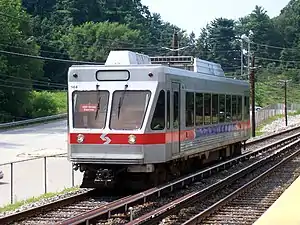 SEPTA N-5 train #144 of the Norristown High Speed Line as it enters the Gulph Mills station in Upper Merion, Pennsylvania. | ||||||||||||||||||||||||||||||||||||||||||||||||||||||||||||||||||||||||||||||||||||||||||||||||||||||||||||||||||||||||||||||||||||||||||||||||||||||||||||||||||||||||||||||||||||||||||||||||||||||||||||||||||||||||||||||||||||||||||||||||||||||||||||||||||||||||||||||||||||||||||||||||||||||||||||||||||||||||||||||||||||||||||||||||||||||||||||||||||||||||||||||||||||||||||||||||||||||||||||||||||||||||||||||||||||||||||||||||||||||||||||||||||||||||||||||||||||||||||||
| Overview | ||||||||||||||||||||||||||||||||||||||||||||||||||||||||||||||||||||||||||||||||||||||||||||||||||||||||||||||||||||||||||||||||||||||||||||||||||||||||||||||||||||||||||||||||||||||||||||||||||||||||||||||||||||||||||||||||||||||||||||||||||||||||||||||||||||||||||||||||||||||||||||||||||||||||||||||||||||||||||||||||||||||||||||||||||||||||||||||||||||||||||||||||||||||||||||||||||||||||||||||||||||||||||||||||||||||||||||||||||||||||||||||||||||||||||||||||||||||||||||
| Locale | Delaware and Montgomery Counties, Pennsylvania, U.S. | |||||||||||||||||||||||||||||||||||||||||||||||||||||||||||||||||||||||||||||||||||||||||||||||||||||||||||||||||||||||||||||||||||||||||||||||||||||||||||||||||||||||||||||||||||||||||||||||||||||||||||||||||||||||||||||||||||||||||||||||||||||||||||||||||||||||||||||||||||||||||||||||||||||||||||||||||||||||||||||||||||||||||||||||||||||||||||||||||||||||||||||||||||||||||||||||||||||||||||||||||||||||||||||||||||||||||||||||||||||||||||||||||||||||||||||||||||||||||||
| Termini | ||||||||||||||||||||||||||||||||||||||||||||||||||||||||||||||||||||||||||||||||||||||||||||||||||||||||||||||||||||||||||||||||||||||||||||||||||||||||||||||||||||||||||||||||||||||||||||||||||||||||||||||||||||||||||||||||||||||||||||||||||||||||||||||||||||||||||||||||||||||||||||||||||||||||||||||||||||||||||||||||||||||||||||||||||||||||||||||||||||||||||||||||||||||||||||||||||||||||||||||||||||||||||||||||||||||||||||||||||||||||||||||||||||||||||||||||||||||||||||
| Stations | 22 | |||||||||||||||||||||||||||||||||||||||||||||||||||||||||||||||||||||||||||||||||||||||||||||||||||||||||||||||||||||||||||||||||||||||||||||||||||||||||||||||||||||||||||||||||||||||||||||||||||||||||||||||||||||||||||||||||||||||||||||||||||||||||||||||||||||||||||||||||||||||||||||||||||||||||||||||||||||||||||||||||||||||||||||||||||||||||||||||||||||||||||||||||||||||||||||||||||||||||||||||||||||||||||||||||||||||||||||||||||||||||||||||||||||||||||||||||||||||||||
| Website | septa | |||||||||||||||||||||||||||||||||||||||||||||||||||||||||||||||||||||||||||||||||||||||||||||||||||||||||||||||||||||||||||||||||||||||||||||||||||||||||||||||||||||||||||||||||||||||||||||||||||||||||||||||||||||||||||||||||||||||||||||||||||||||||||||||||||||||||||||||||||||||||||||||||||||||||||||||||||||||||||||||||||||||||||||||||||||||||||||||||||||||||||||||||||||||||||||||||||||||||||||||||||||||||||||||||||||||||||||||||||||||||||||||||||||||||||||||||||||||||||
| Service | ||||||||||||||||||||||||||||||||||||||||||||||||||||||||||||||||||||||||||||||||||||||||||||||||||||||||||||||||||||||||||||||||||||||||||||||||||||||||||||||||||||||||||||||||||||||||||||||||||||||||||||||||||||||||||||||||||||||||||||||||||||||||||||||||||||||||||||||||||||||||||||||||||||||||||||||||||||||||||||||||||||||||||||||||||||||||||||||||||||||||||||||||||||||||||||||||||||||||||||||||||||||||||||||||||||||||||||||||||||||||||||||||||||||||||||||||||||||||||||
| Type | Interurban/Light rapid transit | |||||||||||||||||||||||||||||||||||||||||||||||||||||||||||||||||||||||||||||||||||||||||||||||||||||||||||||||||||||||||||||||||||||||||||||||||||||||||||||||||||||||||||||||||||||||||||||||||||||||||||||||||||||||||||||||||||||||||||||||||||||||||||||||||||||||||||||||||||||||||||||||||||||||||||||||||||||||||||||||||||||||||||||||||||||||||||||||||||||||||||||||||||||||||||||||||||||||||||||||||||||||||||||||||||||||||||||||||||||||||||||||||||||||||||||||||||||||||||
| System | SEPTA | |||||||||||||||||||||||||||||||||||||||||||||||||||||||||||||||||||||||||||||||||||||||||||||||||||||||||||||||||||||||||||||||||||||||||||||||||||||||||||||||||||||||||||||||||||||||||||||||||||||||||||||||||||||||||||||||||||||||||||||||||||||||||||||||||||||||||||||||||||||||||||||||||||||||||||||||||||||||||||||||||||||||||||||||||||||||||||||||||||||||||||||||||||||||||||||||||||||||||||||||||||||||||||||||||||||||||||||||||||||||||||||||||||||||||||||||||||||||||||
| Services |
| |||||||||||||||||||||||||||||||||||||||||||||||||||||||||||||||||||||||||||||||||||||||||||||||||||||||||||||||||||||||||||||||||||||||||||||||||||||||||||||||||||||||||||||||||||||||||||||||||||||||||||||||||||||||||||||||||||||||||||||||||||||||||||||||||||||||||||||||||||||||||||||||||||||||||||||||||||||||||||||||||||||||||||||||||||||||||||||||||||||||||||||||||||||||||||||||||||||||||||||||||||||||||||||||||||||||||||||||||||||||||||||||||||||||||||||||||||||||||||
| Route number | 100 (former) | |||||||||||||||||||||||||||||||||||||||||||||||||||||||||||||||||||||||||||||||||||||||||||||||||||||||||||||||||||||||||||||||||||||||||||||||||||||||||||||||||||||||||||||||||||||||||||||||||||||||||||||||||||||||||||||||||||||||||||||||||||||||||||||||||||||||||||||||||||||||||||||||||||||||||||||||||||||||||||||||||||||||||||||||||||||||||||||||||||||||||||||||||||||||||||||||||||||||||||||||||||||||||||||||||||||||||||||||||||||||||||||||||||||||||||||||||||||||||||
| Operator(s) | SEPTA Suburban Division | |||||||||||||||||||||||||||||||||||||||||||||||||||||||||||||||||||||||||||||||||||||||||||||||||||||||||||||||||||||||||||||||||||||||||||||||||||||||||||||||||||||||||||||||||||||||||||||||||||||||||||||||||||||||||||||||||||||||||||||||||||||||||||||||||||||||||||||||||||||||||||||||||||||||||||||||||||||||||||||||||||||||||||||||||||||||||||||||||||||||||||||||||||||||||||||||||||||||||||||||||||||||||||||||||||||||||||||||||||||||||||||||||||||||||||||||||||||||||||
| Rolling stock | ASEA Type N-5[1] | |||||||||||||||||||||||||||||||||||||||||||||||||||||||||||||||||||||||||||||||||||||||||||||||||||||||||||||||||||||||||||||||||||||||||||||||||||||||||||||||||||||||||||||||||||||||||||||||||||||||||||||||||||||||||||||||||||||||||||||||||||||||||||||||||||||||||||||||||||||||||||||||||||||||||||||||||||||||||||||||||||||||||||||||||||||||||||||||||||||||||||||||||||||||||||||||||||||||||||||||||||||||||||||||||||||||||||||||||||||||||||||||||||||||||||||||||||||||||||
| Daily ridership | 4,197 (2023)[2] | |||||||||||||||||||||||||||||||||||||||||||||||||||||||||||||||||||||||||||||||||||||||||||||||||||||||||||||||||||||||||||||||||||||||||||||||||||||||||||||||||||||||||||||||||||||||||||||||||||||||||||||||||||||||||||||||||||||||||||||||||||||||||||||||||||||||||||||||||||||||||||||||||||||||||||||||||||||||||||||||||||||||||||||||||||||||||||||||||||||||||||||||||||||||||||||||||||||||||||||||||||||||||||||||||||||||||||||||||||||||||||||||||||||||||||||||||||||||||||
| History | ||||||||||||||||||||||||||||||||||||||||||||||||||||||||||||||||||||||||||||||||||||||||||||||||||||||||||||||||||||||||||||||||||||||||||||||||||||||||||||||||||||||||||||||||||||||||||||||||||||||||||||||||||||||||||||||||||||||||||||||||||||||||||||||||||||||||||||||||||||||||||||||||||||||||||||||||||||||||||||||||||||||||||||||||||||||||||||||||||||||||||||||||||||||||||||||||||||||||||||||||||||||||||||||||||||||||||||||||||||||||||||||||||||||||||||||||||||||||||||
| Opened | 1907 | |||||||||||||||||||||||||||||||||||||||||||||||||||||||||||||||||||||||||||||||||||||||||||||||||||||||||||||||||||||||||||||||||||||||||||||||||||||||||||||||||||||||||||||||||||||||||||||||||||||||||||||||||||||||||||||||||||||||||||||||||||||||||||||||||||||||||||||||||||||||||||||||||||||||||||||||||||||||||||||||||||||||||||||||||||||||||||||||||||||||||||||||||||||||||||||||||||||||||||||||||||||||||||||||||||||||||||||||||||||||||||||||||||||||||||||||||||||||||||
| Technical | ||||||||||||||||||||||||||||||||||||||||||||||||||||||||||||||||||||||||||||||||||||||||||||||||||||||||||||||||||||||||||||||||||||||||||||||||||||||||||||||||||||||||||||||||||||||||||||||||||||||||||||||||||||||||||||||||||||||||||||||||||||||||||||||||||||||||||||||||||||||||||||||||||||||||||||||||||||||||||||||||||||||||||||||||||||||||||||||||||||||||||||||||||||||||||||||||||||||||||||||||||||||||||||||||||||||||||||||||||||||||||||||||||||||||||||||||||||||||||||
| Line length | 13.4 mi (21.6 km)[3] | |||||||||||||||||||||||||||||||||||||||||||||||||||||||||||||||||||||||||||||||||||||||||||||||||||||||||||||||||||||||||||||||||||||||||||||||||||||||||||||||||||||||||||||||||||||||||||||||||||||||||||||||||||||||||||||||||||||||||||||||||||||||||||||||||||||||||||||||||||||||||||||||||||||||||||||||||||||||||||||||||||||||||||||||||||||||||||||||||||||||||||||||||||||||||||||||||||||||||||||||||||||||||||||||||||||||||||||||||||||||||||||||||||||||||||||||||||||||||||
| Number of tracks | 1–3 | |||||||||||||||||||||||||||||||||||||||||||||||||||||||||||||||||||||||||||||||||||||||||||||||||||||||||||||||||||||||||||||||||||||||||||||||||||||||||||||||||||||||||||||||||||||||||||||||||||||||||||||||||||||||||||||||||||||||||||||||||||||||||||||||||||||||||||||||||||||||||||||||||||||||||||||||||||||||||||||||||||||||||||||||||||||||||||||||||||||||||||||||||||||||||||||||||||||||||||||||||||||||||||||||||||||||||||||||||||||||||||||||||||||||||||||||||||||||||||
| Character | Surface (grade separated) | |||||||||||||||||||||||||||||||||||||||||||||||||||||||||||||||||||||||||||||||||||||||||||||||||||||||||||||||||||||||||||||||||||||||||||||||||||||||||||||||||||||||||||||||||||||||||||||||||||||||||||||||||||||||||||||||||||||||||||||||||||||||||||||||||||||||||||||||||||||||||||||||||||||||||||||||||||||||||||||||||||||||||||||||||||||||||||||||||||||||||||||||||||||||||||||||||||||||||||||||||||||||||||||||||||||||||||||||||||||||||||||||||||||||||||||||||||||||||||
| Track gauge | 4 ft 8+1⁄2 in (1,435 mm) standard gauge | |||||||||||||||||||||||||||||||||||||||||||||||||||||||||||||||||||||||||||||||||||||||||||||||||||||||||||||||||||||||||||||||||||||||||||||||||||||||||||||||||||||||||||||||||||||||||||||||||||||||||||||||||||||||||||||||||||||||||||||||||||||||||||||||||||||||||||||||||||||||||||||||||||||||||||||||||||||||||||||||||||||||||||||||||||||||||||||||||||||||||||||||||||||||||||||||||||||||||||||||||||||||||||||||||||||||||||||||||||||||||||||||||||||||||||||||||||||||||||
| Electrification | Third rail, 630 V DC | |||||||||||||||||||||||||||||||||||||||||||||||||||||||||||||||||||||||||||||||||||||||||||||||||||||||||||||||||||||||||||||||||||||||||||||||||||||||||||||||||||||||||||||||||||||||||||||||||||||||||||||||||||||||||||||||||||||||||||||||||||||||||||||||||||||||||||||||||||||||||||||||||||||||||||||||||||||||||||||||||||||||||||||||||||||||||||||||||||||||||||||||||||||||||||||||||||||||||||||||||||||||||||||||||||||||||||||||||||||||||||||||||||||||||||||||||||||||||||
| Operating speed | 55 mph (89 km/h) | |||||||||||||||||||||||||||||||||||||||||||||||||||||||||||||||||||||||||||||||||||||||||||||||||||||||||||||||||||||||||||||||||||||||||||||||||||||||||||||||||||||||||||||||||||||||||||||||||||||||||||||||||||||||||||||||||||||||||||||||||||||||||||||||||||||||||||||||||||||||||||||||||||||||||||||||||||||||||||||||||||||||||||||||||||||||||||||||||||||||||||||||||||||||||||||||||||||||||||||||||||||||||||||||||||||||||||||||||||||||||||||||||||||||||||||||||||||||||||
| ||||||||||||||||||||||||||||||||||||||||||||||||||||||||||||||||||||||||||||||||||||||||||||||||||||||||||||||||||||||||||||||||||||||||||||||||||||||||||||||||||||||||||||||||||||||||||||||||||||||||||||||||||||||||||||||||||||||||||||||||||||||||||||||||||||||||||||||||||||||||||||||||||||||||||||||||||||||||||||||||||||||||||||||||||||||||||||||||||||||||||||||||||||||||||||||||||||||||||||||||||||||||||||||||||||||||||||||||||||||||||||||||||||||||||||||||||||||||||||
The Norristown High Speed Line is unique in its combination of transportation technologies. Originally chartered as a Class I (steam) railroad, the line is fully grade separated, collects power from a third rail, and has high-level platforms common to rapid transit systems or commuter rail systems such as New York City's Long Island Rail Road and Metro-North Railroad, but has onboard fare collection, mostly single-car operation, and frequent stops more common to light rail systems. Previously, the Norristown High Speed Line was considered to be a light rail line, according to a 2008 SEPTA budget report;[6] however, the line is currently considered an interurban heavy rail line, according to a 2009 SEPTA business plan, and subsequent capital budgets.[7][8] It has also been categorized by the American Public Transportation Association as "Intermodal High Speed rapid rail transit".[9]
The service is similiar in design and use to the Ashmont-Mattapan High-Speed Line in Boston. The purple color-coded line was formerly known simply as Route 100, but was officially changed to its current name in September 2009 as part of a customer service initiative by SEPTA.[10]
The line has been subject to multiple accidents. The first recorded crash occurred near an Ardmore stop on January 26, 1987 injuring 19.[11] The operator tested positive for drugs and was convicted on reckless endangerment.[11] Another crash occurred on July 6, 2012 between Beachwood-Brookline and Penfield stations when the cars detached and came back together, injuring 2.[12] In August 2017, there was a crash involving an unoccupied railcar at the 69th Street Terminal that injured more than 40 people. As a result, the maximum operating speed on the line was decreased to 55 mph (89 km/h) from 70 mph (110 km/h).[13]
History
_on_long_trestle_at_Norristown%252C_PA_on_September_28%252C_1969_(22662718556).jpg.webp)
The Norristown High Speed Line began service in 1907 as the Philadelphia and Western Railroad (P&W), which ran from the present 69th Street Terminal in Upper Darby, Pennsylvania to a converted farmhouse station in Strafford, Pennsylvania. In 1911, the line was extended 0.47 miles (0.76 km) west to a new Strafford P&W station adjacent to the Pennsylvania Railroad's Strafford station, allowing easy interchange between the two lines. In 1912, a 6.2-mile (10 km) branch was constructed from Villanova Junction, 0.33 miles (0.53 km) west of the existing Villanova station, to Norristown.[14] When the newly built branch quickly attracted more ridership than the Strafford main line, the Norristown section became the main line and the Strafford stretch was demoted to branch status; in the mid-1930s, the Strafford spur was narrowed to a single track for its last 1.74 miles (2.8 km) between the Wayne-St. Davids and Strafford stations, while the Norristown line received a sleek new art deco terminus at Main and Swede Streets.[14]
Lehigh Valley connection
From Norristown, the P&W RR connected its tracks with the Lehigh Valley Transit Liberty Bell Route to provide direct electric train service from 69th St. Terminal to Allentown, Pennsylvania. However, in 1951, the Lehigh Valley Transit Company ended its service on the Liberty Bell Route, and in 1953 the company ended all its remaining rail service. Two years later, the P&W RR was taken over by the Philadelphia Suburban Transportation Company (PSTC), which was more popularly known as the Red Arrow Lines. In 1956, the Red Arrow abandoned the original branch between Villanova and Strafford, leaving only electric MU train service between 69th Street and Norristown, as it is today.[15] Part of the Strafford branch right of way has been converted into the Radnor Trail. The PSTC was absorbed into SEPTA in 1970,[3] eliminating the original railroad charter and immediately becoming the "Norristown High-Speed Line Trolley", officially known as Route 100.
Ridership
Ridership on the Norristown Line peaked in 2016 at 3,429,300. The previous peak came in 2014 with 3,147,209 trips. Prior to this modern escalation in ridership the line's ridership was highest in 1973 at 2.86 million annual linked trips, and again in 1980 with 2.579 million annual linked trips. Ridership statistics for fiscal years 2000 and later are from SEPTA annual service plans. Data for years 1972 to 1997 are from the SEPTA 1997 ridership census. There may be some discrepancy in how the ridership is reported since the annual service plans report total unlinked trips, while the ridership census uses linked trips, which may exclude passengers transferring from other lines.
| Fiscal year | Average weekday | Annual passengers |
|---|---|---|
| FY 2023 | 4,197 | |
| FY 2019 | 10,893 | |
| FY 2018 | 10,525 | |
| FY 2017 | 11,080 | 3,106,320 |
| FY 2016 | 3,429,300 | |
| FY 2015 | 3,147,209 | |
| FY 2005 | 8,801 | 2,512,690 |
| FY 2004 | 8,428 | 2,463,500 |
| FY 2003 | 7,925 | 2,491,074 |
| FY 2000 | 9,250 | 3,046,927 |
| Fiscal year | Annual linked trips | Fiscal year | Annual linked trips | |
|---|---|---|---|---|
| 1997 | 1,754,000 | 1984 | 2,338,000 | |
| 1996 | 1,696,000 | 1983 | 2,484,000 | |
| 1995 | 1,926,000 | 1982 | 2,089,000 | |
| 1994 | 2,079,000 | 1981 | 1,899,000 | |
| 1993 | 2,251,000 | 1980 | 2,579,000 | |
| 1992 | 2,222,000 | 1979 | 2,133,000 | |
| 1991 | 2,234,000 | 1978 | 1,992,000 | |
| 1990 | 2,162,000 | 1977 | 1,832,000 | |
| 1989 | 2,295,000 | 1976 | 2,218,000 | |
| 1988 | 2,185,000 | 1975 | 2,162,000 | |
| 1987 | 1,888,000 | 1974 | 2,425,000 | |
| 1986 | 1,915,000 | 1973 | 2,860,000 | |
| 1985 | 2,255,000 | 1972 | 2,496,000 | |
21st century
Effective June 14, 2010, SEPTA changed the names of four stations to reflect the streets on which they were located. Township Line Road (formerly West Overbrook Station), Roberts Road (formerly Rosemont Station), Stadium – Ithan Avenue (formerly Stadium Station) and DeKalb Street (formerly King Manor Station).
In summer 2013, SEPTA closed the bridge (the Bridgeport Viaduct) carrying the Norristown High Speed Line over the Schuylkill River for four months.[16][17] The bridge, which was built in 1911, had been deteriorating and needed to be rebuilt at a cost upwards of $30 million, though this repair project was budgeted at $7.5 million.[17] As a result of closing the bridge, buses were used to transport passengers between the Bridgeport station and the Norristown Transportation Center.[18] The bridge was reopened in November 2013.[16][19] The remaining $30 million renovation of the entire bridge structure is currently unscheduled.[19]
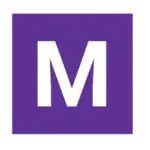
In 2021, SEPTA proposed rebranding their rail transit service as "SEPTA Metro", in order to make the system easier to navigate. Under this proposal, the Norristown High Speed Line will be rebranded as the "M" line (for "Montgomery", the county in which Norristown is located), with a purple color and numeric suffixes for service variants. The local service will be called the M1 Montgomery Local and the peak-hour express service will be called the M2 Montgomery Express. Had the proposed spur to King of Prussia, Pennsylvania been constructed, the proposal would have branded service utilizing the branch as the M3 Montgomery Local to KOP and the M4 Montgomery Express to KOP, providing service between 69th Street Transportation Center, and First & Moore/Valley Forge station, and the M5 Norristown / King of Prussia making local stops between First & Moore/Valley Forge station and Norristown Transportation Center.[21][20] After a period of public comment, SEPTA revised its plans to primarily refer to the line as the "M Line," without number designations.[22]
Service
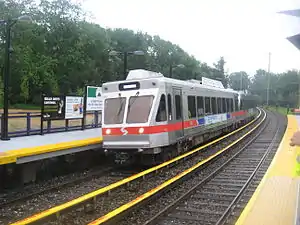
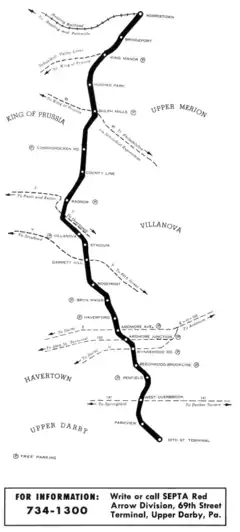
The fare for a single ride as of January 2020 is $2.50 using cash or $2.00 using the Travel Wallet feature on a SEPTA Key card.[23] Until September 1, 2014, the line used a "pay-as-you-exit" fare collection system on trains towards 69th Street Transportation Center. As part of a general change on several routes approaching 69th Street, passengers now pay onboard upon entering the train.[24] Starting February 22, 2021, fares at 69th Street Transportation Center and Norristown Transportation Center are collected from station turnstiles at all times.[25]
The service runs seven days a week from about 5AM to 2AM. Local trains from 69th Street to Norristown stop at all 22 stations, and the trip lasts approximately 30 minutes. Occasionally, local trains may run only between 69th Street and Bryn Mawr, stopping at ten stations, or 69th Street and Hughes Park, stopping at 18 stations.
Prior to 2019 during weekday peak periods (6:00–9:00 AM, 2:15–6:45 PM), the Norristown High Speed Line featured express and limited services, which stop only at select stations, therefore decreasing travel time between 69th Street and Norristown. Norristown Express service, denoted by red destination signs, travels between 69th Street and Norristown in approximately 22 minutes, stopping at only 16 stations. Norristown Limited service, denoted by blue destination signs,travels between 69th Street and Norristown in approximately 26 minutes, and stops at 8 stations. All trains share the same two tracks, so a limited leaving Norristown, for example, will be immediately followed by a local, which stops at more stations, and therefore is spaced farther from the previous train. The next limited will catch up with it. Similarly, a local may leave Bryn Mawr right after an express stops there, and gets to 69th Street just before the next express or limited catches up with it.
A former Hughes Park Express service, was denoted by green destination signs, traveled nonstop from 69th Street to Beechwood–Brookline, and made all stops from there to Hughes Park in approximately 22 minutes.
Station list
Before December 7, 2020, if passengers wanted to board the train at the station, they would have to press a button on the platform, which turns on a light that tells the engineer to stop at the station. The train would only stop if it was scheduled to stop at the station; otherwise, trains did not stop even if the passenger pressed the button. All trains stopped at terminals.
After December 7, 2020, if passengers want to board the train at the station they have to be physically visible to the engineer for the train to stop. This is the same as on a light rail or tram/trolley line. In both cases detraining passengers must press a button on board to request the train to stop.
King of Prussia Spur

In 2013, it was proposed to create a branch off the Norristown High Speed Line to serve the King of Prussia Mall, Valley Forge office parks, and the Valley Forge Casino Resort.[27] Many possible routes were planned for this extension, including one following US 202 from Norristown to King of Prussia, another following a utility right-of-way paralleling US 202 and the Pennsylvania Turnpike, and another following the utility right-of-way and Gulph Road.[28] In 2014, SEPTA estimated that the expansion would cost between $500 million to $650 million, and was at least eight years away.[29]
On February 29, 2016, SEPTA announced the preferred route based on cost-efficiency and environmental impact.[30] The route would have branched off from the main Norristown High Speed Line between Hughes Park and DeKalb Street, followed a PECO transmission line right-of-way to the Pennsylvania Turnpike, and then run parallel to the Turnpike to reach the King of Prussia Mall. It would then have followed Mall Boulevard before crossing the Turnpike and following First Avenue. Stations would have been located at Henderson Road, Allendale Road, Mall Boulevard, the intersection of First and Clark Avenues in the King of Prussia Business Park, and at First Avenue near the Valley Forge Casino Resort.[31]
On January 25, 2018, the SEPTA board approved a final route alignment, selecting the locally preferred routing from among the options studied in the project's draft environmental impact statement (EIS).[32] The 4.5-mile (7.2 km) line was estimated to cost between $1 billion and $1.2 billion, with ridership estimated at 9,500 daily by 2040.[32] In January, 2019, SEPTA engaged the engineering firm HNTB to design Phase I of the project.[33] On December 1, 2020, SEPTA held a meeting to update the proposed alignment. The final environmental impact statement was planned to be submitted to the Federal Transit Administration (FTA) in early 2021. Construction on the spur to King of Prussia was projected to cost $2 billion and service was expected to begin between 2025 and 2027.[34]
Five new stations were to be added to the line as follows:[31]
- Henderson Road station
- Allendale Road station
- Mall Boulevard station
- First & American Forge station
- First & Moore/Valley Forge station (terminus)
On March 17, 2023, SEPTA stopped work on the extension of the Norristown High Speed Line to King of Prussia after determining it would not have the money to proceed forward after the FTA denied a capital grant to the project.[35]
Notes
- "SEPTA Operating Facts Fiscal Year 2013" (PDF). SEPTA. 2013. p. 3. Retrieved November 12, 2013.
- "Fiscal Year 2020 Annual Service Plan" (PDF). SEPTA. July 2019. p. 38. Retrieved September 27, 2020.
- "SEPTA - Media Guide" (PDF). Southeastern Pennsylvania Transportation Authority. 2013. Retrieved November 12, 2013.
- "How to Ride - Norristown High Speed Line". I SEPTA Philly. Retrieved February 13, 2020.
- "Fiscal Year 2020 Annual Service Plan" (PDF). SEPTA. July 2019. Retrieved September 27, 2020.
- "Fiscal 2008 Operating Budget" (PDF). SEPTA. 2008. p. 1. Archived from the original (PDF) on November 25, 2008. Retrieved June 1, 2009.
- "SEPTA Five-Year Strategic Business Plan" (PDF). SEPTA. p. 4. Retrieved June 1, 2009.
- "SEPTA Fiscal Year 2016 Capital Budget" (PDF).
- "American Public Transportation Association - A MULTIMODAL TOUR OF THE DELAWARE VALLEY" (PDF). American Public Transportation Association (APTA). June 1, 2013. Archived from the original (PDF) on November 11, 2013. Retrieved November 10, 2013.
- Nussbaum, Paul (July 22, 2009). "SEPTA seeks input on Regional Rail name changes". The Philadelphia Inquirer. Archived from the original on July 25, 2009. Retrieved January 10, 2010.
- Fazlollah, Mark. "Notable SEPTA train accidents". The Philadelphia Inquirer. Retrieved September 15, 2020.
- "Seven hurt when SEPTA trains collide". The Philadelphia Inquirer. July 6, 2012. Retrieved September 15, 2020.
- Laughlin, Jason (September 29, 2017). "Speed reduced on Norristown High-Speed Line in wake of crash". Philly.com. Retrieved December 22, 2018.
- DeGraw, Ronald (2007). Pig & Whistle: The Story of the Philadelphia & Western Railway. Chicago: Central Electric Railfans' Association. ISBN 978-0-915348-40-4
- Bell, Jon (March 22, 2006). "Philadelphia, Pennsylvania: Norristown High Speed Line". Presbyterian College. Archived from the original on July 8, 2007. Retrieved August 1, 2007.
- "Bridgeport Viaduct Improvement Project Recap". SEPTA. November 14, 2013. Retrieved December 8, 2013.
- Adkins, Lynne (July 8, 2013). "Four-Month Construction Project Gets Underway On The Norristown High Speed Line". CBS Philly (CBS 3). Retrieved November 12, 2013.
- Nussbaum, Paul (December 14, 2012). "SEPTA to close Norristown line's rail bridge over Schuylkill". The Philadelphia Inquirer. Interstate General Media, LLC. Retrieved December 19, 2012.
- "Bridgeport Viaduct to reopen for Norristown high-speed line". The Philadelphia Inquirer. Interstate General Media, LLC. November 4, 2013. Retrieved November 12, 2013.
- "Wayfinding Recommendations". SEPTA. Retrieved September 7, 2021.
- Vitarelli, Alicia; Staff (September 7, 2021). "SEPTA Metro? Transit agency mulling big changes including new name, map, and signage". Philadelphia, PA: WPVI-TV. Retrieved September 7, 2021.
- "Design Concept Feedback". planning.septa.org. SEPTA. Retrieved March 19, 2023.
- "Fares". SEPTA. Retrieved November 30, 2017.
- "Pay As You Enter". SEPTA. Retrieved December 13, 2014.
- "69TH ST & NORRISTOWN TRANSPORTATION CENTER TURNSTILES OPERATIONAL AT ALL TIMES". SEPTA. February 22, 2021.
- "Fiscal Year 2020 Annual Service Plan" (PDF). SEPTA. Retrieved September 27, 2020.
- Geringer, Dan (July 16, 2013). "SEPTA mulls rail service to King of Prussia, Valley Forge". The Philadelphia Inquirer. Retrieved July 17, 2013.
- Parks, Jessica (July 17, 2013). "SEPTA studies high-speed rail extension to King of Prussia". The Philadelphia Inquirer. Retrieved July 17, 2013.
- Shelly, Jared (January 30, 2014). "SEPTA's new plans for $500M King of Prussia Rail project". Philadelphia Business Journal. Retrieved October 7, 2014.
- Smith, Sandy (February 29, 2016). "SEPTA Picks a King of Prussia Rail Route". Philadelphia Magazine. Retrieved March 2, 2016.
- "King of Prussia Rail Project Interactive Map". King of Prussia Rail. Retrieved December 2, 2020.
- "Septa moves forward with King of Prussia Rail Project". International Rail Journal. January 26, 2018. Retrieved January 28, 2018.
- Anna Merriman (January 28, 2019). "SEPTA awards $7M contract for first part of KOP rail design". Curbed Philadelphia. Retrieved April 3, 2019.
- Madej, Patricia (December 2, 2020). "SEPTA doubles down on commitment to $2B King of Prussia Rail project". The Philadelphia Inquirer. Retrieved December 2, 2020.
- Fitzgerald, Thomas (March 17, 2023). "SEPTA stops work on proposed King of Prussia Rail Line after federal government denies funding". The Philadelphia Inquirer. Retrieved March 17, 2023.
References
- "U.S. Urban Rail Transit Lines Opened From 1980" (PDF). Archived from the original (PDF) on November 4, 2013.
- "Transportation Planning Capacity Building Program - Peer Exchange Report". Delaware Valley Regional Planning Commission. June 16, 2004. Archived from the original on July 30, 2009.
- "Norristown Extension of Philadelphia & Western Railway". Electric Railway Journal. Vol. XL, no. 16. McGraw Publishing Co. October 26, 1912. p. 906.
External links
- Official website
- "Norristown High Speed Line schedule" (PDF). (164 KB)
- "The Modernization of SEPTA Norristown High Speed Line (Includes ABB N-5 Specifications)" (PDF). Archived from the original on January 24, 2016.
{{cite web}}: CS1 maint: bot: original URL status unknown (link) (6.03 MB)
